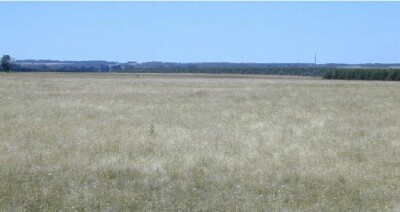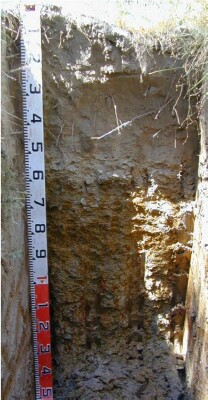JEE98 (Plot 4)
| Site: JEE98 (Plot 4) | Land Unit: Dundas Redgum |
| Aust. Soil Class.: | |
 | General Land Unit Description: The flat surface of the Dundas Tablelands predominantly consists of Brown Chromosols and to a lesser extent Yellow Chromosols with a ferric horizon, typically occurring above the clay subsoil. The soil is commonly developed over a highly weathered mottled zone. This red and white mottling, sometimes referred to as ‘tiger mottles’, is thought to be the result of deep chemical weathering which occurred during the late Tertiary period. Red gums are the dominant vegetation found on this surface. Two year old Eucalyptus globulus plantation on ex-agricultural land. |
Site Description:
| Geology: Cainozoic duricrust | Landform pattern: Gently undulating plains |
| Position in landscape: Flat | Internal drainage: Imperfectly drained |
| A1 | 0-30 cm | Dark greyish brown (10YR4/2) sandy loam; single grain structure; loose consistence when dry; common medium roots; clear and smooth transition to: |  |
| A2 | 30-60 cm | Very pale brown (10YR7/3) loamy sand; single grain structure; loose consistence when dry; common medium roots; clear and smooth transition to: | |
| Subsoil | |||
| Bs | 60-70 cm | Very pale brown (10YR7/3) loamy sand; single grain structure; loose consistence when dry; very many coarse ferruginous nodules; few very fine roots; abrupt and wavy transition to: | |
| B21 | 70-110 cm | Brown (10YR6/3) with common medium faint reddish yellowish red (5YR5/6) and brownish yellow (10YR6/6) mottles, light medium clay; moderate polyhedral structure (20-50 mm) parting to moderate polyhedral structure (10-20 mm); weak consistence when moderately moist; common very fine macropores; areal porosity 0.05%; few very fine roots; gradual and smooth transition to: | |
| B22 | 110-150 cm | Light grey (10YR7/2) with many coarse distinct reddish brown (5YR4/4) and brownish yellow (10YR6/6) mottles, medium clay; strong polyhedral structure (20-50 mm) parting to strong subangular blocky structure (5-10 mm); firm consistence when moderately moist; common very fine macropores; areal porosity 0.05%; no roots observed. | |
| 150-390 cm | Heavy grey clays (slickensides) with red and orange segregations in areas, remnant roots between cracks and segregations down to 390 cm, live roots observed to 250 cm. |
Sampled by: Ian Sargeant, Paul Feikema and Kiet Quach (7 December, 2000).


